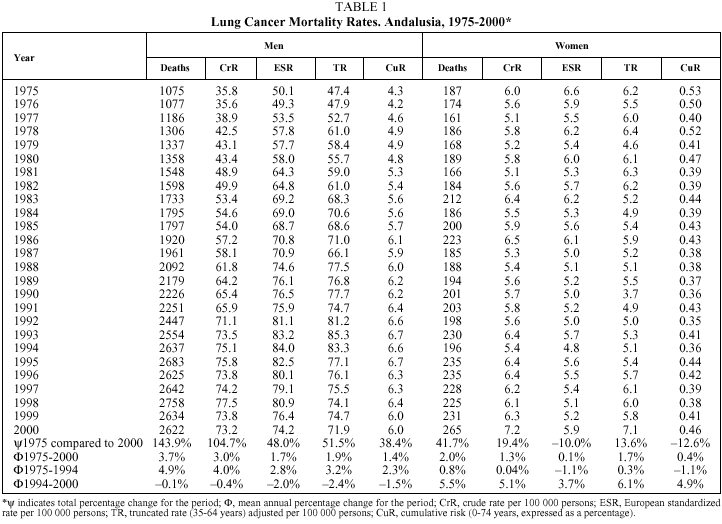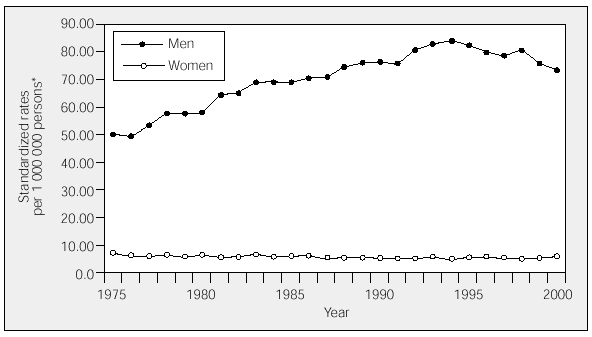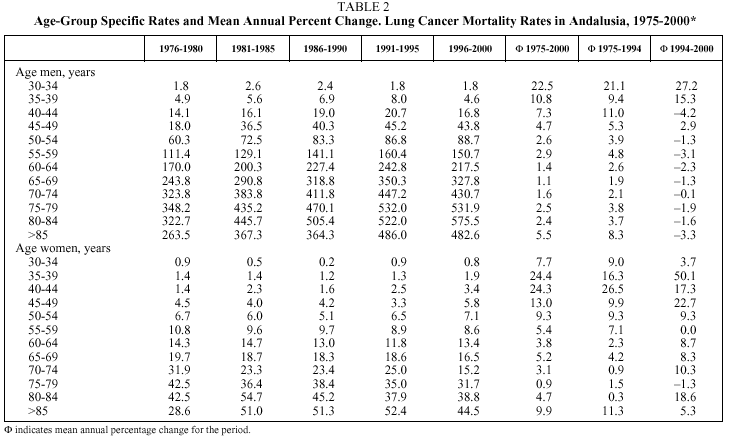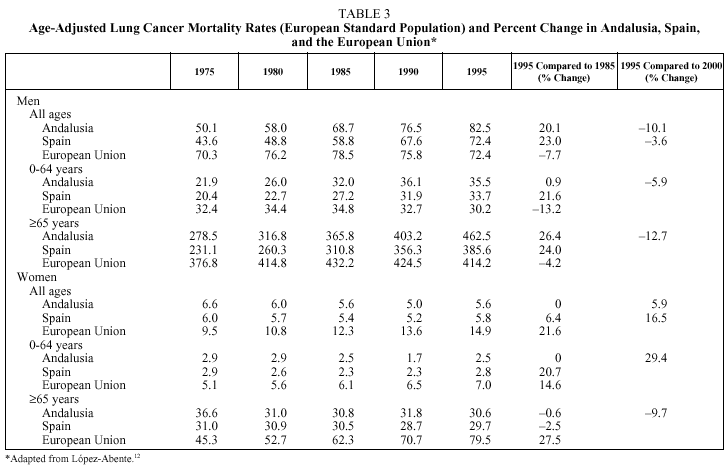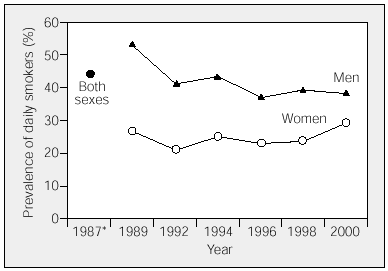Introduction
In Europe lung cancer is the leading cause of cancer deaths in men and the third in women.1 Smoking, the main risk factor for lung cancer, is responsible for 85% to 90% of deaths from this disease.2 In the year 2000 the estimated number of deaths worldwide attributable to smoking was 4.9 million, surpassing 1990 estimates by 1 million. It is industrialized countries, however, that have the largest proportion of smoking related diseases.3
In 1998 smoking was responsible for some 56 000 deaths among adults in Spain. In men, lung cancer is still the main cause of death attributable to smoking. In women, lung cancer is already the second smoking-related cause of death, just after chronic obstructive pulmonary disease, and before cerebrovascular diseases. The change in rank for lung cancer among women is due to the increased prevalence of smoking and the increased number of deaths from the disease.4
At the end of the 20th century a decrease in the mortality rate from lung cancer was observed in men living in Mediterranean countries. This decrease was attributed to changes in smoking patterns beginning in the 1970's.5,6 The pattern in Mediterranean countries is similar to that observed in Northern European countries where, however, this change was observed almost a decade earlier.7,8
In previous publications we analyzed the trend in lung cancer mortality in Andalusia in the period from 1975 through 1992, for which we observed a marked increase in mortality rates for men (62%) and a decrease for women (-24%).9 In the present study we propose to contribute updated information on lung cancer mortality in Andalusia and to determine the trends for the period from 1975 through 2000.
Subjects and Method
We performed a descriptive study of mortality from tracheal, bronchial, and lung cancer, using secondary data sources. The study population consisted of the residents of the autonomous community of Andalusia, Spain, during the period from 1975 through 2000.
Information on deaths from the aforementioned causes and on the populations needed to calculate the various indicators was supplied in magnetic format by the Statistical Institute of Andalusia.
In order to facilitate interpretation of the data, we calculated, in addition to the absolute number of deaths, the crude, age-specific, standardized (by the direct method, using Segi's10 European standard population as a reference), and truncated (35-64 years, 0-64 years and ≥65 years) rates. We also calculated the cumulative rate,11 as it has the advantage of requiring simpler calculations and circumventing the arbitrary selection of a standard population. Its main usefulness, however, lies in the fact that it provides a good approximation of the cumulative risk, the indicator presented in Table 1. Cumulative risk is the risk of a person dying from a disease during a given period of time if no other causes of death existed. Normally the time period considered is between 0 and 74 years.
Results
Lung cancer is the most frequent tumor in men in Andalusia. In the year 2000 it was the cause of 2 622 deaths in men and 265 in women, which represents 30% and 5% of deaths, respectively, from malignant tumors in Andalusia. Table 1 shows the number of deaths, the crude, standardized, truncated (35-64 years) and cumulative rates for lung cancer deaths in Andalusia (1975-2000) for men and women. The age-adjusted lung cancer mortality rate for the time period studied rose from 50.1 per 100 000 men in 1975 to 74.2 in the year 2000, with a mean annual increase of 1.7%. These rates reached their highest point in 1994, with 84 deaths per 100 000 persons/year and fell in later years (Table 1 and Figure 1). For women, mortality rates were 8- to 13-fold lower than for men and showed a slight annual decrease of 0.5%.
Figure 1. Lung cancer mortality trend (Andalusia, 1975-2000). *European standard population.
For women, the risk of dying of lung cancer before the age of 75 years, calculated from the cumulative rate, fell from 0.53% in 1975 to 0.46% in 2000. This means that at the beginning of the period studied 1 out of every 188 women died of this disease; by the end of the period this ratio had decreased to 1 out of every 215. The trend for men was somewhat different, with risk rising from 4.3% to 6.0% in the same period; 1 out of every 23 men died of this disease at the beginning of the period, and 1 out of every 17 at the end.
Table 2 shows the cumulative 5-year rates by age group and sex, as well as the mean percent changes for the periods from 1975 through 2000, 1975 through 1994, and 1994 through 2000. In men, the rates decreased in all age groups over 50 years during the period from 1994 through 2000. The rates were much lower in women, although increases were observed for the 35 to 39- and 45 to 49-year age groups and are reflected in the 6.1% increase in truncated rates (34-65 years) in the 1994 to 2000 period (Table 1). In older women, rates fluctuated more in the different age groups, although overall the truncated rate (≥65 years) fell by 9.7% in the 1995 to 2000 period (Table 3).
Table 3 shows the overall age-adjusted and truncated (0-64 and ≥65 years) mortality rates from lung cancer by sex for Andalusia, Spain, and for the European Union.12 Most striking is the difference between the changes in lung cancer mortality in Andalusia and in the European Union as a whole during the period studied.
Discussion
Before considering the results, we must comment on the quality of the data and the methodology used. Due to the lack of morbidity data available, we used mortality data, as they constitute the only available source of data on the national and local levels and they also satisfy the criteria of continuity and comprehensiveness.13
In our case we can consider mortality figures a reliable indicator of the frequency of lung cancer, both because of the low patient survival rates (despite diagnostic and therapeutic advances, lung cancer still remains highly lethal, with fewer than 15% of patients surviving 5 years after diagnosis)14 and because of the accuracy of the information on death certificates mentioning lung cancer as cause of death in our context.15 Furthermore, we also analyzed truncated rates (<65 years), for which the quality of information as to cause of death is greater.
Various studies have quantified the relative risk of lung cancer from exposure to tobacco smoke (about 10, with a strong dose-response relationship).16 Moreover, if the prevalence of exposure to tobacco smoke in the general population is about 36%, the population attributable fraction is probably close to 80%, which shows the impact that eliminating exposure would have on the incidence of and mortality from lung cancer. For this reason we feel that primary prevention, that is smoking avoidance or cessation, is an effective measure at our disposal that would have a significant effect not only on lung cancer, but also on tumors at other sites (oropharynx, larynx, esophagus, bladder, etc) and on other diseases (ischemic heart disease, chronic bronchial disease). Nevertheless, the latest report of the Preventive and Health Promotion Activities Program (PAPPS) of the Spanish Society of Family and Community Medicine indicates that only 33% of smokers were advised to stop smoking and 39% of them were followed up.
Although much emphasis has been placed on the limitations of epidemiological findings based on mortality studies, they nonetheless still provide a basic tool for understanding the disease and its determinants.17 Thus, for example, the time-series analysis of mortality has shown that variation in smoking prevalence over time is responsible for the trends in lung cancer mortality in Mediterranean men, and that the observed downward trend occurred almost a decade behind the one observed in Northern and Eastern European men.18
Our results indicate that in Andalusia lung cancer mortality in men reached its highest level in 1994 and began to fall thereafter (Figure 1). This is similar to the trend observed in Barcelona, where the fall in lung cancer mortality rates was preceded by a decline in the prevalence of smoking among men.19 Considering the changes in smoking prevalence by sex in our part of Spain20 (Figure 2), we can expect this favorable trend to continue in the coming years, as there is no other factor that can explain it.
Figure 2. Prevalence of daily smokers by sex (Andalusia, 1987-2000). *For 1987 the variable of tobacco consumption was not analyzed by sex.
In 1995 the standardized ratio (men to women) was 15 in Andalusia, 12 in Spain, and 5 in the European Union (Table 3), which probably reflects delayed initiation of regular smoking and lower professional risk in Andalusian women. However, the increase observed in truncated rates (35-64 years) may reflect the increase in smoking among women in recent decades21 and we can expect the trend to extend to older age groups in the coming years. We may see the situation of women, years ago a privileged one, begin to worsen rapidly in the near future. The social cost of this trend will be seen when the cohorts of young women, who have taken up smoking on a large scale, reach the ages at which the symptoms of smoking-related diseases begin to appear.
In Andalusia a progressive increase in smoking among young people between 1987 and 1999 was observed, especially in the 12 to 15-year age group.22 In the report published in 2000 for that period, it was observed that smoking initiation was highest in the 16 to 24-year age group, which accounted for nearly half the total, and that the mean age was 16 years.20
Although smoking prevalence has decreased, lung cancer still constitutes an important public health problem in Andalusia. For this reason, the courageous lawsuit that the autonomous government of Andalusia has filed against the tobacco companies for the harm they cause but do not bear the cost of is worthy of note.23 Also, the availability of and increased access to effective new smoking cessation interventions may contribute to a decrease in morbidity and mortality from lung cancer and associated heath care costs in Andalusia.
Correspondence: Dr. A. Cayuela.
Unidad de Apoyo a la Investigación. Edificio de Laboratorios. Hospitales
Universitarios Virgen del Rocío.
Avda. de Manuel Siurot, s/n. 41013 Sevilla. España.
E-mail: aurelio.cayuela.sspa@juntadeandalucia.es
Manuscript received March 27, 2003.
Accepted for publication June 3, 2003.


